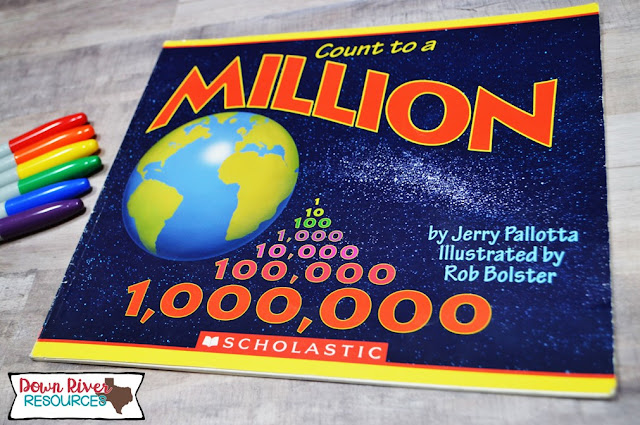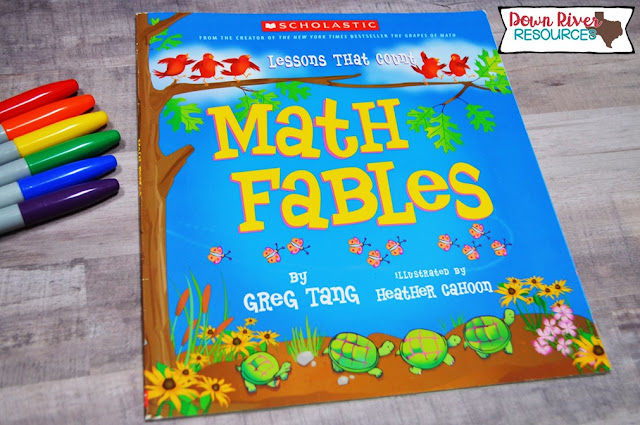One of my favorite things to do is walk into a bookstore. It doesn't matter if it is a big box bookstore or the Friends of the Library resell shop in town. I love books... especially children's picture books. Before I started teaching, I would buy any and all books. I have had to be more strategic as the years have passed and the space to shelve these books shrinks. My focus has been building a collection of diverse and rigorous books which I can use to teach mathematics. I buy math picture books now! I have four favorites that I use for teaching place value! I hope this list helps you as you grow your math picture book library!
Picture books provide an opportunity to open mathematical discussions with children. This list will help you find the best picture books to use with your classroom to facilitate their learning of place value. Each of these titles specifically teach mathematical concepts about place value and were written to inform the reader about them. This is not an exhaustive list of books that can be used to teach this skill, but a solid start of titles that I actually own and use!
This post contains affiliate links for Amazon. I only recommend items that I own and use to my Valued Partners. By purchasing an item on the Amazon site using these links, I will receive a very small commission on your purchase that allows me to maintain this website. Thank you for your continued support!
Popular children's author, Jerry Pallotta, hits it out of the ballpark again with this title, Count to a Million! If you can count to ten, you can count to one million! That's a pretty bold statement! Although some may have their doubts, readers will find themselves counting higher than they ever thought possible, inspiring even the most reluctant math student, as they build confidence and have fun.
How Much is a Million? by David M. Schwartz is a great story about large numbers. Ever wonder just what a million of something actually means? How about a billion? Or a trillion? Marvelosissimo, the mathematical magician, can teach you! Say that two times fast! How Much is a Million? breaks down complex numbers down to size in a fun and humorous way that helps children conceptualize a difficult mathematical concept.
Math Fables: Lessons That Count by Greg Tang is an amazing resource for teaching children their math skills, in particular place value! Through these “fables” about concepts that are relevant to the very youngest math learners, including sharing, teamwork, etc., Tang encourages children to see the basics of addition and subtraction in entirely new ways. Fresh, fun, and most of all, inspiring, this title is perfect for launching young readers on the road to math success!
The Best Picture Books for Place Value
Picture books provide an opportunity to open mathematical discussions with children. This list will help you find the best picture books to use with your classroom to facilitate their learning of place value. Each of these titles specifically teach mathematical concepts about place value and were written to inform the reader about them. This is not an exhaustive list of books that can be used to teach this skill, but a solid start of titles that I actually own and use!
This post contains affiliate links for Amazon. I only recommend items that I own and use to my Valued Partners. By purchasing an item on the Amazon site using these links, I will receive a very small commission on your purchase that allows me to maintain this website. Thank you for your continued support!
 |
| Count to a Million |
Count to a Million
Popular children's author, Jerry Pallotta, hits it out of the ballpark again with this title, Count to a Million! If you can count to ten, you can count to one million! That's a pretty bold statement! Although some may have their doubts, readers will find themselves counting higher than they ever thought possible, inspiring even the most reluctant math student, as they build confidence and have fun.
 |
| Earth Day-Hooray! |
Earth Day-Hooray!
I can't get enough of the MathStart books by Stuart J. Murphy! Earth Day–Hooray! is one of his most popular children’s books too! Earth Day-Hooray! is a story about Ryan, Luke, and Carly. These friends need to collect and recycle 5,000 cans if they want to make enough money to plant flowers in the park. This story is a two-for-one lesson about recycling and the math skill of place value. Your students will be counting by groups of hundreds, tens, and ones as you read this title to them! |
| How Much is a Million? |
How Much is a Million?
How Much is a Million? by David M. Schwartz is a great story about large numbers. Ever wonder just what a million of something actually means? How about a billion? Or a trillion? Marvelosissimo, the mathematical magician, can teach you! Say that two times fast! How Much is a Million? breaks down complex numbers down to size in a fun and humorous way that helps children conceptualize a difficult mathematical concept.
 |
| Math Fables: Lessons That Count |
Math Fables: Lessons That Count
 |
| Click Here to Join! |
Don't Judge a Book by Its Cover!
Other Place Value Titles on my Personal Wish List
Place Value by David A. Adler (Popular Author)- This is a newly released book!
You had better not monkey around when it comes to place value. The monkeys in this book can tell you why! As they bake the biggest banana cupcake ever, they need to get the amounts in the recipe correct. There’s a big difference between 216 eggs and 621 eggs. Place value is the key to keeping the numbers straight. Using humorous art, easy-to-follow charts and clear explanations, this book presents the basic facts about place value while inserting some amusing monkey business.
Sir Cumference and All the King's Tens: A Math Adventure by Cindy Neuschwander
Join Sir Cumference and the gang for more wordplay, puns, and problem solving in the clever math adventure about place-value and counting by tens. Sir Cumference and Lady Di planned a surprise birthday party for King Arthur, but they didn’t expect so many guests to show up. How many lunches will they need? And with more guests arriving by the minute, what about dinner? Sir Cumference and Lady Di count guests by tens, hundreds, and even thousands to help young readers learn place-value. Fans will love this new installment of the Sir Cumference series that makes math fun and accessible for all.
A Million Dots by Andrew Clements
It's a long way to
a million, right?
Of course it is.
But do you really know
what a million looks like?
If you'd like to see -- actually see, right now, with your own eyes -- what a million looks like, just open this book.
Be prepared to learn some interesting things along the way. Like how many shoe boxes it would take to make a stack to Mount Everest. And be prepared to do some number wondering of your own. But, most of all, be prepared to be amazed. Because a million is a LOT of dots.
I hope this post inspires you to use picture books as you teach place value.
What are some of the math picture books you use in your classroom?










